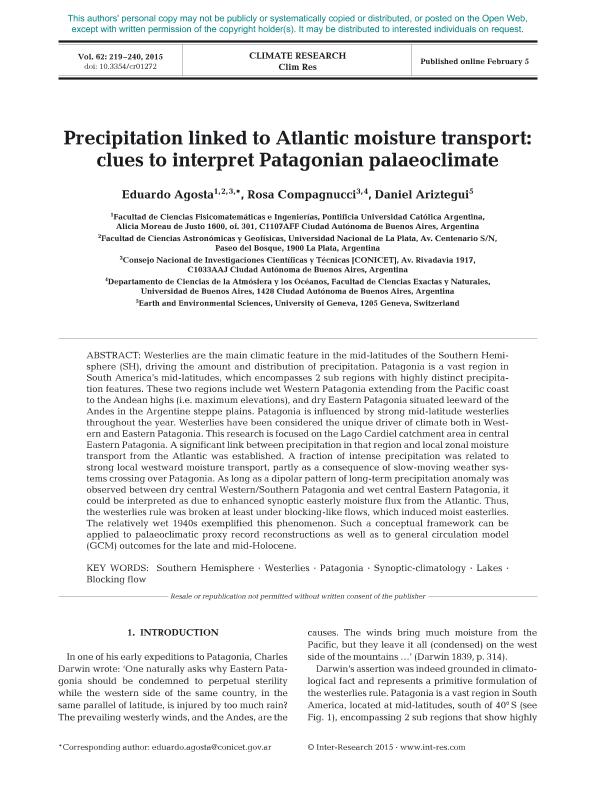Artículo
Precipitation linked to Atlantic moisture transport: clues to interpret Patagonian palaeoclimate
Fecha de publicación:
02/2015
Editorial:
Inter-Research
Revista:
Climate Research
ISSN:
0936-577X
Idioma:
Inglés
Tipo de recurso:
Artículo publicado
Clasificación temática:
Resumen
Westerlies are the main climatic feature in the mid-latitudes of the Southern Hemisphere (SH), driving the amount and distribution of precipitation. Patagonia is a vast region in South America’s mid-latitudes, which encompasses 2 sub regions with highly distinct precipitation features. These two regions include wet Western Patagonia extending from the Pacific coast to the Andean highs (i.e. maximum elevations), and dry Eastern Patagonia situated leeward of the Andes in the Argentine steppe plains. Patagonia is influenced by strong mid-latitude westerlies throughout the year. Westerlies have been considered the unique driver of climate both in Western and Eastern Pata gonia. This research is focused on the Lago Cardiel catchment area in central Eastern Patagonia. A significant link between precipitation in that region and local zonal moisture transport from the Atlantic was established. A fraction of intense precipitation was related to strong local westward moisture transport, partly as a consequence of slow-moving weather systems crossing over Patagonia. As long as a dipolar pattern of long-term precipitation anomaly was observed between dry central Western/Southern Patagonia and wet central Eastern Patagonia, it could be interpreted as due to enhanced synoptic easterly moisture flux from the Atlantic. Thus, the westerlies rule was broken at least under blocking-like flows, which induced moist easterlies. The relatively wet 1940s exemplified this phenomenon. Such a conceptual framework can be applied to palaeoclimatic proxy record reconstructions as well as to general circulation model (GCM) outcomes for the late and mid-Holocene.
Palabras clave:
Synoptic Climatology
,
Westerlies
,
Patagonia
,
Blocking Flow
Archivos asociados
Licencia
Identificadores
Colecciones
Articulos(SEDE CENTRAL)
Articulos de SEDE CENTRAL
Articulos de SEDE CENTRAL
Citación
Agosta Scarel, Eduardo Andres; Compagnucci, Rosa Hilda; Ariztegui, Daniel; Precipitation linked to Atlantic moisture transport: clues to interpret Patagonian palaeoclimate; Inter-Research; Climate Research; 62; 3; 2-2015; 219-240
Compartir
Altmétricas




